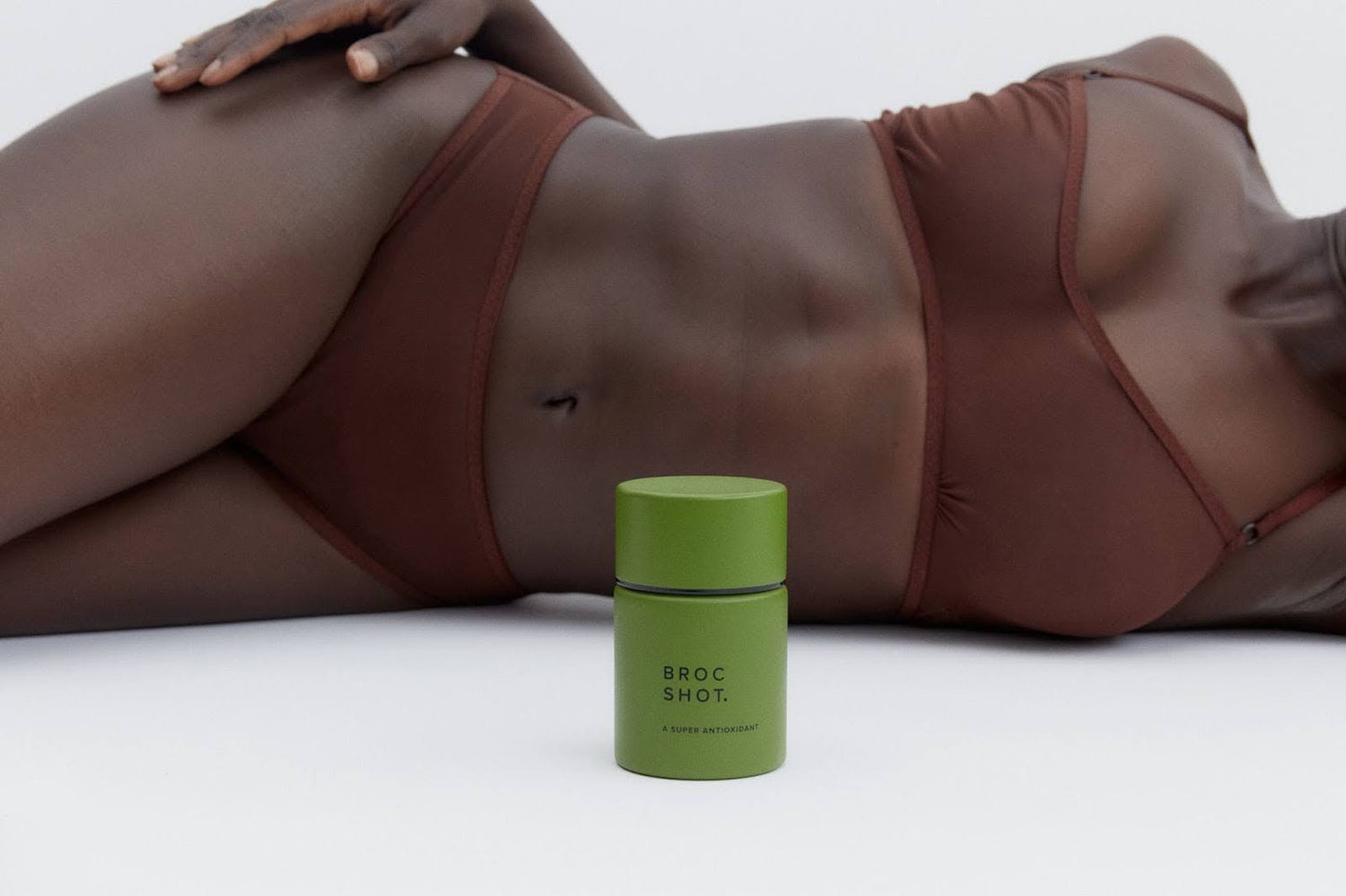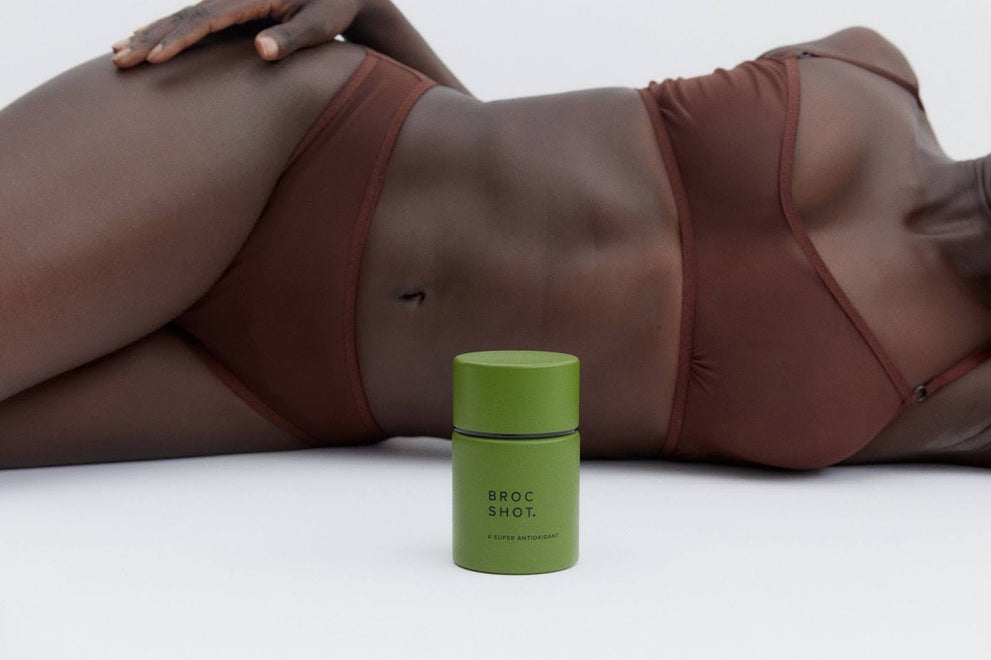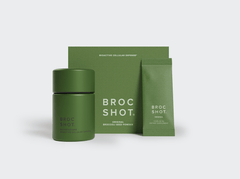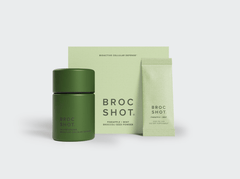Key Takeaways:
- Optimal Daily Dose: Research suggests 10–20 mg of sulforaphane per day provides significant cellular support and detoxification benefits.
- Food Isn’t Always Enough: The sulforaphane dose in whole broccoli varies, and cooking can drastically reduce its potency.
- Broc Shot Delivers Quality, Consistent Results: Each shot delivers 12–16 mg of natural sulforaphane, equivalent to eating 5–10 pounds of raw broccoli.
If you’ve heard about sulforaphane’s benefits for detox, inflammation, and gut health, you’ve probably wondered: how much sulforaphane per day is necessary to be effective?
Sulforaphane is a natural phytochemical found in broccoli and other cruciferous vegetables. But the amount you actually absorb from food depends on preparation, enzyme activity, and individual gut function.
In this blog, we’ll break down what the science says about sulforaphane dosage, explain how much sulforaphane is in broccoli, and show why Broc Shot provides the most efficient way to deliver an effective dose of active sulforaphane.
What The Science Says About Sulforaphane Dosage
Clinical research suggests that an effective sulforaphane dosage ranges from 10 to 20 mg per day. This amount is based on human trials measuring antioxidant response, detox enzyme activation, and inflammation reduction. Doses within this range have been shown to stimulate the body’s natural defense systems, without the risks or variability found in food-only sources.
A study involving broccoli sprout extract showed that participants who consumed sulforaphane daily experienced significant detoxification and antioxidant activation. That same level of effect is difficult to replicate through food alone due to cooking losses and storage degradation.
How Much Sulforaphane Is in Broccoli?
Here’s the challenge: while broccoli contains glucoraphanin (the precursor to sulforaphane), it doesn’t always effectively produce sulforaphane in the body. Most people would need to eat 5–10 pounds of raw broccoli to achieve a clinical sulforaphane dose, which is not realistic or sustainable.
Raw Broccoli
May yield 1–5 mg of sulforaphane per 100g, depending on the myrosinase enzyme content. This variability depends on broccoli variety, freshness, and how the vegetable was grown or stored, all factors that make dietary intake inconsistent.
Cooked Broccoli
Often contains less than 1 mg of sulforaphane per serving due to heat-sensitive enzyme destruction. This loss occurs because cooking, especially boiling or microwaving, destroys the myrosinase enzyme required for sulforaphane formation, significantly reducing its bioavailability.
Broccoli Sprouts
Higher concentrations of broccoli sprouts are inconsistent and prone to mold or contamination if not carefully processed. While sprouts can offer high sulforaphane potential, their effectiveness depends on freshness, handling, and the presence of active enzymes. Additionally, improper storage or unsanitary sprouting conditions may increase the risk of microbial contamination, making consistent dosing and safety difficult to control.
Why Broc Shot Offers Reliable Sulforaphane Dosage
Broc Shot was developed to overcome these challenges by providing a daily sulforaphane supplement.
Each shot contains 12–16 mg of natural sulforaphane, derived from whole broccoli seed powder (not sprout powder). That means:
- Consistent, clinically relevant dosing
- Active enzyme preserved for proper sulforaphane conversion
- No contamination risk
Broc Shot is tested for potency, pesticide-free, and delivered in compostable packaging. With Broc Shot, you get real and reliable delivery of active natural sulforaphane.
How Much Sulforaphane Per Day Is Too Much?
While there’s no established upper limit for sulforaphane intake, most research caps intake around 40 mg per day. Doses over 20 mg have not been linked to harm, but keep in mind that the body can only absorb so much at once.
Higher doses of sulforaphane do not necessarily translate to better results. Sulforaphane works best as a daily support system, not a mega-dose. This is why a consistent dose like Broc Shot’s 12–16 mg range is ideal for long-term use.
How Sulforaphane Supports Daily Wellness
Sulforaphane doesn’t just work on one system; it supports the entire body by triggering detoxification enzymes, helping reduce inflammation, and defending against oxidative damage. These functions are particularly important for individuals exposed to everyday toxic chemicals, processed foods, and chronic stress. With daily intake, sulforaphane helps the body stay ahead of environmental damage and improves resilience over time.
By supporting gut restoration and encouraging a healthier microbiome, sulforaphane also helps improve digestion and nutrient absorption. This downstream benefit supports everything from mood and skin health to immune response. A consistent daily dose of sulforaphane, like Broc Shot’s 12–16 mg, ensures your body gets what it needs to perform at its best.
The benefits of an effective sulforaphane dosage can show up in multiple systems of the body:
- Enhances detoxification by activating Phase II enzymes
- Minimizes inflammation through NF-κB downregulation
- Supports gut restoration by improving microbiome resilience and intestinal lining integrity
- Reduces oxidative stress at the cellular level
- May improve skin quality, cognitive clarity, and immune function
Learn more about sulforaphane’s broader roles in your daily health, through topics such as:
Factors That Affect Sulforaphane Absorption
Even with the right food sources, your body’s ability to absorb sulforaphane can vary widely. One major factor is enzyme activity, specifically, whether the enzyme myrosinase is present to help convert glucoraphanin into sulforaphane. Without myrosinase, either naturally present in raw foods or included in a supplement like Broc Shot, sulforaphane won’t become bioactive in the body. Temperature and storage conditions of broccoli powder also degrade glucoraphanin and myrosinase activity, which is why many store-bought vegetables and powders fall short on sulforaphane delivery.
Another key factor in sulforaphane absorption is your gut microbiome. Certain gut bacteria can assist with sulforaphane conversion, but not everyone has the same bacterial diversity or function. Individuals with compromised gut health may struggle to convert precursors into their active form. Broc Shot bypasses this issue by delivering natural sulforaphane in a ready-to-absorb state, ensuring you get the benefits regardless of gut variability.
Getting sulforaphane from food depends on several things:
- Presence of Myrosinase: This enzyme is needed to convert precursors into active sulforaphane
- Gut Bacteria Activity: Some gut microbiomes are better at processing precursors than others
- Cooking Method: Steaming can preserve enzymes; boiling or microwaving destroys them
- Time Since Harvest: Sulforaphane precursors degrade during storage
Broc Shot’s broccoli supplement controls all these variables by delivering sulforaphane in a potent, tested form.
Sulforaphane For Different Lifestyles: Who Benefits Most?
While everyone can benefit from daily sulforaphane, certain lifestyles make it even more essential. Athletes, frequent travelers, urban dwellers, and those exposed to environmental toxins all place a higher burden on detoxification and inflammation control to maintain health. Daily sulforaphane intake can offer measurable support in performance, resilience, and recovery for these groups.
Even those pursuing preventative wellness strategies, such as biohackers or individuals with a family history of chronic illness, may turn to sulforaphane for its science-backed support of antioxidant defense and hormone balance. Broc Shot offers a high-quality, efficient source of natural sulforaphane, no matter your lifestyle.
How Sulforaphane Complements A Healthy Diet
Even the best diets can fall short on active sulforaphane. That’s because cooking methods, vegetable sourcing, and enzyme degradation make it hard to consistently reach an optimal sulforaphane dose through food alone. Sulforaphane-rich foods like broccoli, kale, and cabbage are helpful, but unpredictable in their sulforaphane delivery.
Adding a consistent sulforaphane supplement like Broc Shot ensures that you receive a reliable daily dose. When paired with a whole-food, plant-forward diet, Broc Shot becomes a powerful tool to reinforce the body’s natural defenses without relying solely on what’s on your plate.
Timing Your Sulforaphane Dose For Best Results
When it comes to sulforaphane, consistency is more important than timing. Broc Shot can be taken any time of the day, with or without food, so it’s easy to make Broc Shot a part of your everyday routine.
Sulforaphane is not stored in the body long-term, so daily use is required to maintain benefits. Unlike synthetic vitamins that build up over time, sulforaphane works best in a steady rhythm to continuously support detoxification and inflammation reduction.
How Broc Shot Makes Dosing Simple And Effective
Most people don’t have the time or interest in calculating the sulforaphane dose in their broccoli or worrying about raw vs. cooked vegetables. Broc Shot eliminates that guesswork with a precisely measured, 12–16 mg natural sulforaphane dose every day.
With Broc Shot, there’s no mixing powders, sprouting seeds, or refrigerating greens. Just shake and drink. Broc Shot lets consistent sulforaphane dosing become effortless—so you can focus on feeling better, not figuring out your supplement math.
Sulforaphane And Long-Term Health Outcomes
When taken consistently in optimal amounts, sulforaphane may contribute to better long-term health. Studies have linked it to reduced biomarkers of chronic disease, improved cellular resilience, and healthier aging. These benefits stem from sulforaphane’s ability to help reduce oxidative stress, support mitochondrial function, and maintain proper inflammatory balance.
Incorporating sulforaphane daily is a simple but powerful strategy for preventative wellness. With Broc Shot delivering a clinical sulforaphane dose every day, you're reinforcing the body’s natural defenses over time—without relying on inconsistent food sources or complicated supplement routines.
Final Thoughts
So, how much sulforaphane per day is optimal? The sweet spot is 10–20 mg, according to clinical research. Food alone rarely provides this dose reliably. That’s why Broc Shot exists: to ensure your body receives consistent, bioactive natural sulforaphane in a meaningful dose every single day.
Sulforaphane’s ability to help enhance detoxification, minimize inflammation, and support gut restoration makes it one of the most versatile compounds in any wellness protocol.
Read also:
- Nutrient-Rich Foods That May Boost Immunity While Undergoing Chemotherapy
- Sulforaphane Benefits for Skin: Natural Support for Radiance And Repair
- How Compounds in Broccoli Sprouts May Support Cancer Defense
Frequently Asked Questions About How Much Sulforaphane You Should Take Per Day
How much sulforaphane per day is safe?
Most studies use daily doses between 10 and 40 mg, with no serious side effects reported. Broc Shot delivers 12–16 mg per serving, which is within the optimal and safe range for sulforaphane dosing. It’s also third-party tested to ensure purity.
Can I get enough sulforaphane from broccoli?
Not reliably. Even raw broccoli varies in sulforaphane content depending on enzyme activity and growing conditions. Cooking reduces potential sulforaphane content even further. That’s why Broc Shot is a better solution for active, natural sulforaphane.
What is the optimal sulforaphane dosage for detox?
Research shows that around 10–20 mg of sulforaphane daily activates detox pathways like glutathione and GST. This dosage range helps your liver process toxins efficiently and safely.
Does myrosinase matter in sulforaphane supplements?
Yes, it’s essential. Without myrosinase, glucoraphanin (the precursor to sulforaphane) won’t convert to active sulforaphane. Broc Shot includes the enzyme myrosinase naturally through whole broccoli seed powder.
How much sulforaphane is in 100 grams of broccoli?
Raw broccoli may contain up to 5 mg of sulforaphane per 100 grams—but this varies. Cooking can reduce that to under 1 mg per serving. Most people would need to eat pounds of broccoli daily to match the natural sulforaphane in a single Broc Shot.
What makes Broc Shot different from broccoli supplements?
Most supplements use dried powder or sprout blends with little or no active sulforaphane. Broc Shot ensures activation, potency, and absorption with each serving.
Should I take sulforaphane every day?
Yes. Daily dosing supports long-term detox, inflammation control, and gut repair. Sulforaphane isn’t stored in the body, so consistent intake is key.
Can sulforaphane help with inflammation?
Absolutely. Sulforaphane activates the Nrf2 pathway and suppresses pro-inflammatory markers like NF-κB. This supports joint health, recovery, and immune function.
How long before I see benefits from sulforaphane?
Some people feel results from sulforaphane in as little as 7–10 days, especially in digestion and clarity. Full antioxidant and detox effects may take a few weeks of consistent use.
Is there such a thing as too much sulforaphane?
Large doses over 40 mg haven’t shown harm in studies, but more isn’t always better. The body responds best to moderate, consistent dosing like Broc Shot’s 12–16 mg natural sulforaphane per day.
Sources:
- Baralić, K., Živanović, J., Marić, Đ., Bozic, D., Grahovac, L., Antonijević Miljaković, E., Ćurčić, M., Buha Djordjevic, A., Bulat, Z., Antonijević, B., & Đukić-Ćosić, D. (2024). Sulforaphane-A Compound with Potential Health Benefits for Disease Prevention and Treatment: Insights from Pharmacological and Toxicological Experimental Studies. Antioxidants (Basel, Switzerland), 13(2), 147. https://doi.org/10.3390/antiox13020147
- Coyle, D. (2019, February 26). Sulforaphane: Benefits, side effects, and food sources. Healthline. https://www.healthline.com/nutrition/sulforaphan
- Houghton, C. A., Fassett, R. G., & Coombes, J. S. (2016). Sulforaphane and Other Nutrigenomic Nrf2 Activators: Can the Clinician's Expectation Be Matched by the Reality?. Oxidative medicine and cellular longevity, 2016, 7857186. https://doi.org/10.1155/2016/7857186







